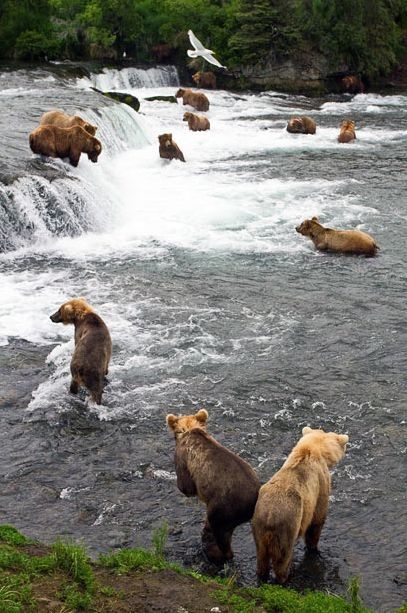|
|
Bears Fishing For Salmon
|
Salmon eggs are laid in freshwater streams typically at high latitudes. The eggs hatch into alevin or sac fry. The fry quickly develop into parr with camouflaging vertical stripes. The parr stay for 6 months to three years in their natal stream before becoming smolts, which are distinguished by their bright silvery colour with scales that are easily rubbed off. It is estimated that only 10% of all salmon eggs survive to this stage. The smolt body chemistry changes, allowing them to live in salt water. Smolts spend a portion of their out-migration time in brackish water, where their body chemistry becomes accustomed to osmoregulation in the ocean.
The salmon spend about one to five years (depending on the species) in the open ocean where they become sexually mature. The adult salmon return primarily to their natal stream to spawn. In Alaska, the crossing-over to other streams allows salmon to populate new streams, such as those that emerge as a glacier retreats. The precise method salmon use to navigate has not been established, though their keen sense of smell is involved. Atlantic salmon spend between one and four years at sea. (When a fish returns after just one year's sea feeding it is called a grilse in the UK and Ireland.) Prior to spawning, depending on the species, salmon undergo changes. They may grow a hump, develop canine teeth, develop a kype (curvature of the jaws in male salmon). All will change from the silvery blue of a fresh run fish from the sea to a darker color. Salmon can make amazing journeys, sometimes moving hundreds of miles upstream against strong currents and rapids to reproduce. Chinook and sockeye salmon from central Idaho, for example, travel over 900 miles (1,400 km) and climb nearly 7,000 feet (2,100 m) from the Pacific ocean as they return to spawn. Condition tends to deteriorate the longer the fish remain in fresh water, and they then deteriorate further after they spawn, when they are known as kelts. In all species of Pacific salmon, the mature individuals die within a few days or weeks of spawning, a trait known as semelparity. Between 2% and 4% of Atlantic salmon kelts survive to spawn again, all females. However, even in those species of salmon that may survive to spawn more than once (iteroparity), post-spawning mortality is quite high (perhaps as high as 40 to 50%.)
|
|









